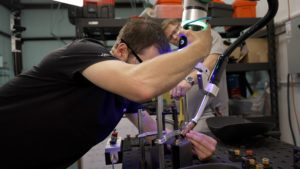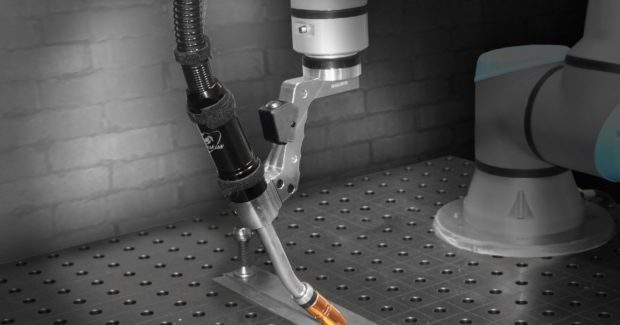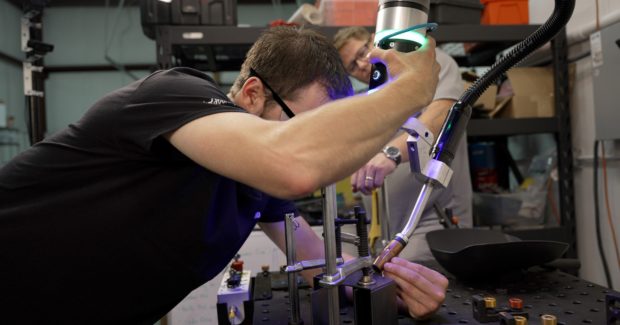Answers to Common Questions About Cobots and Cobot MIG Guns
Optimize the use of cobots by selecting high-quality MIG guns and consumables that will assist in improving your shop’s efficiency and throughput.
Posted: April 18, 2022
WELDING TIPS

Manufacturing operations can reap many benefits from traditional robotic welding systems, but this technology may not be right for every application.
When a traditional robotic system isn’t the answer, manufacturers can consider collaborative robots, also called cobots. These systems are growing in popularity with manufacturers as the technology continues to evolve.
Cobots require a lower initial investment than traditional robotic systems while still helping operations save time, improve part quality and achieve consistency. Learn more about the benefits of cobots and get answers to frequently asked questions, including how to choose the right welding gun and consumables to optimize their performance.
Q: How are cobots different from traditional robotic weld cells?
A: As their name suggests, collaborative robots are industrial robots that are designed to operate safely alongside workers. One example of this human collaboration is when a cobot welds a workpiece while the operator works nearby, inspecting and cleaning a weld that was recently completed by the cobot. This enables more work to be done in the same amount of time.
Q: When are cobots a good fit for an operation?
A: Cobots are a good fit for operations that produce smaller numbers of many types of parts (high-mix, low-volume production), such as the applications found in job shops and general manufacturing.
Q: What benefits can an operation gain from implementing cobots?
A: Cobots can deliver numerous benefits for many applications, including:
- Fast training and ease of use: While some training is required, little welding or programming experience is needed to properly operate a cobot. This differs from a traditional robotic weld cell, which often requires programming or welding experience. Operations faced with skilled labor shortages can benefit from cobots because less training is required. In addition, cobots are typically easy to use thanks to intuitive touch-screen interfaces.
- Lowered safety risks: Cobots are designed with many built-in safety features that allow them to be operated alongside human workers. Cobots do not have pinch points, are limited in how fast they can move, and are very sensitive to collisions. If a collision does happen, the cobot will not be moving very fast and it will stop immediately. When they aren’t working alongside a human operator, cobots can be programmed to move faster.
- Improved portability: Many cobots can be easily moved to where they are needed, allowing manufacturing operations to change which production line is using the cobot.
- Lower costs: Implementing cobots is typically less expensive for manufacturers than a traditional robotic welding cell. Not only is the initial cost lower for cobots, but it often takes less time to train operators on the systems, which can save operations money and improve productivity. And because many robot integrators offer cobot leasing options, manufacturers can test a cobot solution first to decide if it’s the right fit.
Q: What are best practices for choosing a cobot welding gun and consumables?
A: As with any welding system, the gun and consumables for cobots play a key role in performance. Consider these tips when making the selection:
- Choose high-quality consumables: Consumables that are engineered to optimize uptime through long product life and quick replacement can pay dividends in throughput and productivity. For example, AccuLock™ R contact tips, nozzles and gas diffusers have coarse tip threads that help prevent cross-threading problems. This eliminates a common source of welding downtime, especially with less experienced operators who are not as familiar with proper installation practices.
- Know the rating: The same standards used to test and rate traditional MIG guns are also used for cobot MIG guns. Understanding MIG gun ratings will help in choosing the right gun for the application and prevent gun overheating when they are used as rated.
- Consider the mounting: Some MIG guns are designed to optimize installation and mounting. The Tregaskiss BA1 cobot MIG gun features metal-to-metal connections that hold it in place in the mounting arm. This keeps the aluminum-armored neck firmly connected in the gun body to ensure accurate, quality welds. Installation of the gun and mounting arm are also quick and easy thanks to a design with minimal fasteners and a precision-machined keyway mounting system.
- Simplify liner maintenance: Liner issues and replacement challenges are common causes of troubleshooting, so choosing a liner system that makes replacement easier can reduce or eliminate these problems. Front-load liners, which are replaced from the front of the gun, can help decrease downtime caused by changeover. This liner style allows liner replacement without disturbing the gun, wire or feeder connection.
The Benefits of Cobots
In the right manufacturing operations, cobots can improve efficiency and throughput and help ease the burden for operations that are dealing with a shortage of skilled welders. Cobots are known for being quick to install and easy to use but choosing high-quality MIG guns and consumables is an important factor in optimizing performance.

















